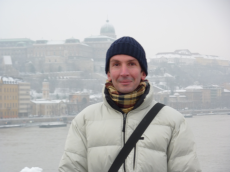BIOGRAPHY
Resume - Artist Statement
RESUME
Didier LACOUR
Born in 1973, Lives and works in Paris
Education: Self-taught artist
Special interests: abstract & contemporary fine-art, art from indigenous people.
I'm a self-taught artist. While I had being studying science and technology at the university I discovered technical drawing and computer aided drawing. Since this moment, drawing entered in my life. Step by step, I have been adding color and payed more and more attention to painting.
On the same time, I used to spend more time to visit museums, art galleries and exhibitions. These visits allowed me both to discover drawing as well as painting and to improve and train my sight for art pieces. It is a pleasure that has been lasting since nowadays when I'm still continuing these visits as often as possible. This is a way to get inspiration, a way to discover what happens on the word of art today and to chat with the actors of the actual world of art.
Artists who used many colors as did the "Fauves", the "Naïfs", the "Dadas" first interested me and inspired me as well, this is probably an inspiration that provided me guidance during my first works. Since I have been brought up on the countryside, natural environment was an important source of inspiration as well for me, and such it is nowadays as well. My last projects are directly attached to the interaction of the men and their environment, especially how do they perceive the environment and how do they mark it.
Lately I had the chance to travel and to discover different cultures: the Maori culture in New-Zealand and the Aboriginal culture in Australia. Several stays in this area of the Pacific allowed me to discover a different way of thinking as well as a different way of dealing with the environment. It was a revelation to me: the way aboriginal people perceive their environment allows much more importance for supernatural and intuitive approach of the world than we use to do. The Maori's pieces of art and the contemporary aboriginal paintings were the origin of reflection and recent inspiration that I had great pleasure to discover. Aboriginal paintings, colored and elaborated thanks to an apparently simple pictorial code but subtly codified impressed me a lot. I had been surprised when I discovered the similarity that exists between the travels of these people into their land and the pieces of art they made. Some aboriginal paintings depict a route to find an important, sometime sacred, place such as a water point for example.
This idea of progression, of path, of sacred places pleased me and I had been trying to compare this view to the one that occidental societies may have regarding their environment. To do so, I had been inspired also by the scientific approach that we have concerning a natural place. Since I had been working for a long time in a laboratory dealing with analysis of environment samples, as a scientist I could discover analytical representations such as microscopic views from environmental samples, geological maps, diagrams, etc. This material showed me that our natural environment may be analyzed, scrutinized, and interpreted thank to scientific tools, which leads to another interpretation than the one a aboriginal people may have done.
Then, I thought it could be interesting to initiate a talk between imagination, intuition, technology and analyze in such a way that two views of the environment, two different ways to get a path or an itinerary in the world around us could be a way to bring mutual enrichment.
ARTIST STATEMENT
Faced with certain works of art, particularly those of indigenous peoples, understanding may fail giving way to senses providing an interpretation that is far from our concept: powerful, mysterious and lively.
It is in fact this way of dealing with a subject that inspires me. I am used to drawing to tell stories, painting seems to me to be the driving force of narrative. I imagine the topic as if it stems from a variety of connected components, entwined by the substance of the drawing.
This slow maturing process begins with the writing of a short text to set down the subject that enables me to produce several sketches leading to a finalized drawing. I like to alternate between different working states like repetition and nothingness which gives time for growth. This process could be similar to the organic slowness of metamorphosis.
Over the course of journeys, readings, exhibitions and research, an abundance of inspirational elements are provided for later use. I appreciate materials which are easy to use and carry: paper, pencils, gouache for example.
Not long ago, I discovered the eventuality of making a topical series. Then an interesting challenge appears: to produce elements of a set which are mutually based on one another and act in harmony while having still their own character. In this approach, the representation of the subject according to various points of view may invite the onlooker to consider a new interpretation, to examine and dig for the appropriate story.
